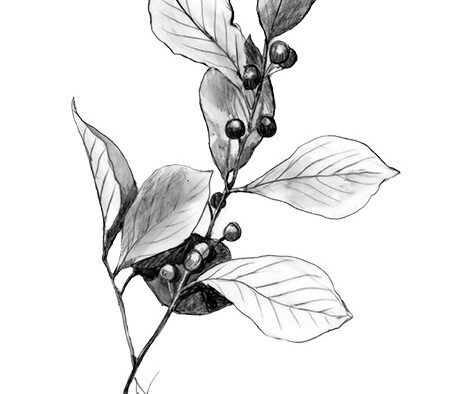Of all the non-native, invasive plants in the Northeast, buckthorn is among the most hated by forest stewards. There are two types of invasive buckthorn in our region: glossy buckthorn (Frangula alnus) and common buckthorn (Rhamnus cathartica), also called European buckthorn. Both plants grow quickly, have prolific seed spreading habits, and have become so detrimental to native species that many states – including Vermont, New Hampshire, and Maine – ban their sale.
Both buckthorns have oval leaves, and both produce flowers every year. However, variations in the leaves and flowers separate the two species. Glossy buckthorn has entire leaf edges (no teeth) and white flowers with both stamen and pistil. Common buckthorn has finely toothed leaves and yellow-green flowers, which have either stamens or pistils – not both. (There is a native species of buckthorn in our region, alder-leaved buckthorn, Rhamnus alnifolia, which grows in wetlands. It has more pointed leaves, flowers without petals, and reaches a maximum height of only a few feet.)
Both invasive buckthorn species thrive in canopy gaps and along forest edges, where plenty of light reaches the forest floor. In either location, buckthorn arrives via birds that eat the fruit and leave fertile seeds behind in their droppings. Buckthorn’s growth quickly surpasses that of young native trees, and if left unchecked, it will grow as high as 30 feet, with stems a few inches thick.
There are, however, ways to combat buckthorn. These include mechanical methods, chemical control, and a combination of both. Mechanical removal of buckthorn involves pulling plants from the soil or cutting established stems. Pulling is most effective on seedlings and saplings (no more than 2 feet tall) where the entire root system can be removed at once. Cutting is a better option for larger trees, although they are likely to resprout. Chemical control involves the use of herbicides.
Thomas Lee, associate professor emeritus at University of New Hampshire, who has studied glossy buckthorn for many years, recommends combining mechanical and chemical removal methods. He suggests cutting stems as close as possible to the base of the shrub, which will limit the new stems the plant can produce. Within 20 minutes of cutting, use a paintbrush or other applicator to apply a herbicide such as glyphosate on the cut base. Be careful to restrict the herbicide to the cut stems. If applied more broadly, it may harm other plants in the treatment area. Also take the time to understand where even targeted glyphosate use is not recommended, for example, in areas where it may wash into sensitive wetlands. Herbicide is unlikely to be effective early in the growing season, or if applied before rainy weather, when it can wash beyond the treated area. The best time to apply herbicide is during a stretch of dry days from late summer through winter.
Unlike many other invasive plants, buckthorn reproduces solely by seed. That seedbank requires consistent monitoring to keep buckthorn in check. Recent research has found that seeds may live only a couple of years with common buckthorn, but glossy buckthorn seeds may be viable for several years. Keep an eye out for buckthorn seedlings, which look like miniature versions of adults. Uprooting works here, but Lee notes that this disturbs the soil, especially when pulling bigger plants, which can damage the soil ecosystem. Another control method is to use dark plastic cloth to cover buckthorn stems within a few days of cutting to prevent light from reaching them.
Regardless of the method you employ, Lee said, “If you’re really going to control [buckthorn], you have to be persistent.”
I have used a combination of mechanical and chemical treatments in an effort to control a buckthorn shrub growing at the base of a white pine in my yard. The shrub was too large to dig up, so for several years I cut the stems. Each time I cut the plant, it came back, developing into a dense clump of 20 or so stems. Then, last year, I dosed the cut stems with herbicide. After that treatment, no new shoots emerged, and this year I was able to kick the buckthorn, roots and all, off the pine tree base against which it was growing.
I know this is just one battle won in the buckthorn war, and I continue to monitor my yard. I search high and low, keeping a look out for buckthorn, from fruiting adults to little ones growing from the seedbed.
Jenna O’del is a biologist and science writer based in Rhode Island. Illustration by Adelaide Murphy Tyrol. The Outside Story is assigned and edited by Northern Woodlands magazine and sponsored by the Wellborn Ecology Fund of the New Hampshire Charitable Foundation: www.nhcf.org.





